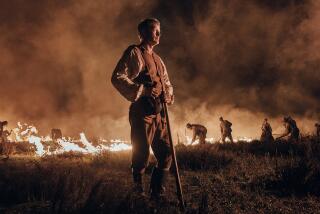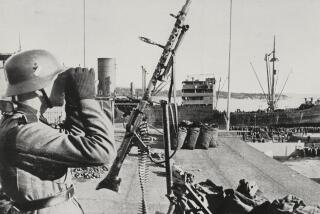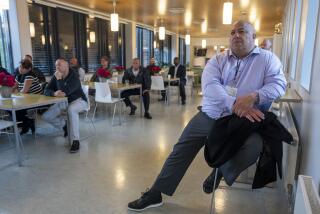Denmark Becomes 51st State Every Fourth of July
- Share via
ALBORG, Denmark — On the Fourth of July in Denmark, drums roll and horns sound to the beat of “Stars and Stripes Forever,” the breezes carrying the noise to picnicking families on the hills of Rebild.
For 77 years, except during two World Wars, this small Scandinavian country of 5 million people has celebrated the birthday of the United States at Rebild, the country’s only national park, and in Alborg, a city 15 miles from the park.
At Rebild, flags from the two nations fly everywhere. Also, along the walk leading to the park’s natural amphitheater is a special tribute--flags from every American state.
Denmark’s celebration of the Fourth of July means oratory by prominent Danes and Americans, sing-alongs to such songs as “Home on the Range,” folk and square dancing, Danish youth choirs, a U.S. Air Force marching band and a California high school band complete with pompon girls.
Visiting Americans are amazed. This is Denmark, land of Hans Christian Andersen, of Hamlet’s castle, of a flag affectionately called “Dannebrog.”
Why all the hoopla here over the Fourth of July, about 4,000 miles east of the White House?
The answer reads like a fairy tale. The story began 13 decades ago.
From the mid-1880s through the turn of the century, one of every 10 Danes left their native country for America. Many were poor farmers seeking fresh soil, a new economy and an education for their children. Although they settled across the United States, the majority stayed in the upper Midwest.
In 1912 the Danish-American Society was founded in Chicago. That same year the society bought 200 acres near Alborg, an old port city on sailboat-dotted Lim Fiord, about 160 miles northwest of Copenhagen.
Centuries ago, wandering Visigoths revered this tranquil area of heather-laden hills and woods as verdant as County Cork. But the society found that most of the beloved heather had been sacrificed to the plow.
The society replanted the heather and donated the land to the Danish government, then ruled by King Christian X. But it also wanted to honor the nation that had welcomed 500,000 Danish immigrants. The society told the king that in accepting the land, there is one very important stipulation--America’s Fourth of July must be celebrated in Rebild every year.
His Majesty agreed.
King Christian X made the area a national park to stand as a symbol of the close friendship between the United States and Denmark.
Though the “Star-Spangled Banner” is sung only on the Fourth of July in Rebild, visitors are reminded of American-Danish kinship throughout the year.
A large Lincoln-type log cabin, constructed in 1934 as a memorial museum, symbolizes homes built in the United States by emigrants in the mid-1880s. Each of America’s then-48 states contributed a log.
Over the years Rebild’s celebration has featured many speakers, including Walter Cronkite, Earl Warren, Walt Disney, Hubert Humphrey, Raymond Burr, Richard Nixon, Jean Hersholt, Danny Kaye, Ronald Reagan and Dionne Warwick.
As Old Glory is raised to fly beside the red-and-white Dannebrog, Danes stand and cheer.
“I’ve never felt so appreciated as an American,” said teacher Elaine Boettcher of Oak Park, Ill., as she stood to sing the National Anthem.
“Just gives me goose bumps all over,” said Chris Thomsen, toting a huge American flag that he brought from the States when he left a year ago to retire here, the land of his birth.
Hot Dogs, Ice Cream
Munching foot-long hot dogs and licking ice cream cones wrapped in red, white and blue, the audience eagerly follows the festivities.
Rebild’s square dancers don’t have to travel far to display their Western attire and fancy steps. These dashing Texas-style dancers live in Alborg.
Alborg is an easy-to-walk-about city of 155,000 people, many of whom greet strangers with a merry “ God dag “ (good day). Denmark’s fourth-largest metropolis, this city of half-timbered houses and numerous restaurants, museums and amusement parks is the cultural center of northern Jutland.
About 1,200 years ago, Alborg was a key Viking stronghold. The Norsemen’s largest burial ground in all of Scandinavia is here; 682 tombs beneath a broad greensward are marked with large rocks, many set in the shape of a ship.
Here, as everywhere in Denmark, folks are keen about bicycles and pedestrian shopping streets. The old section has an abundance of both.
The best-loved and liveliest street, belying its saintly name, is Jomfru Ane Gade (Virgin Ann). Lined with discos, restaurants, jazz spots and pubs, Jomfru Ane Gade is an area where the sun never sets--which, in summer, is almost true.
Alborg is on the same parallel as Juneau, Alaska. In this latitude the Scandinavian sun doesn’t draw its shades and go to bed until almost the stroke of midnight.
Sunset lovers are in for a treat. Brilliant reds and orange, blanketing the sky, are stitched with lavender and pink. Rich burgundy bedecks the waters like a quilt.
Long hours of daylight on the Fourth of July mean that fireworks don’t begin until midnight. But there’s still plenty of time to enjoy both the ceremonies at Rebild and the flavor of Alborg.
In the morning, a parade winds through the old town. Marching bands blare out John Philip Sousa favorites as fervently as any Veteran of Foreign Wars brass band.
Meanwhile, at the Duus Wine Cellar in the Renaissance-era Jens Bang’s House, revelers gather to skol each other with beer and aquavit.
For an elegant Fourth of July smorgasbord and after-dinner dance, attend the lavish Danish-American party in the city’s conference center, Alborg Hall. Tables the length of a Viking ship gleam with the harvest of land and sea as white-gloved waiters uncork champagne.
Across from Alborg Hall hundreds of lanterns light Kilde Park, site of more festivities. There, popcorn and ice cream, hot dogs and Danish beer are dished up to the beat of disco, Big Band and country dancing.
When the sun finally retires, the night sky flames with the incandescent light of spinning pinwheels, bursting rockets and shooting fountains. One firework follows another like barraging sequins fired from heavenly cannons.
-- -- --
Many of the Fourth of July festivities in Alborg are free; others charge admission or are by invitation only. Free concerts are given by the U.S. Air Force Europe Band, Radio Denmark Girl’s Choir and the Danish-American Garden Party for American guests.
In Alborg, get information on all events, along with tickets, at the Fourth of July Reception and Registration Office at Hotel Hvide Hus, Vesterbro 2.
Tickets for the Danish-American dinner-dance at Alborg Hall cost 220 krone per person (about $33 U.S.).
Buses for the ceremonies at Rebild leave Hotel Hvide Hus at 11 a.m., round trip about $7.50. Admission to the Rebild celebration is about $3 U.S.
Chalk-Mine Gallery
Near Rebild is an unusual and dramatic art gallery. At the hamlet Thingbaek--in an old chalk mine--are about 100 gypsum sculptures by A. J. Bundgaard and C. J. Bonnesen. Bronze works cast from these models decorate city squares throughout Denmark.
The chalk mine also is home to five species of bats. In winter they hibernate in their museum/mine, but fly out by the hundreds in the spring, returning in the fall.
Alborg has many attractions, including the Museum of Fine Art, which houses outstanding works by Danish artists and other 20th-Century masters; a castle dating to 1539, with a dungeon and underground passages; a historical museum featuring a room from a well-to-do home of 1602 and a monastery with frescoes from the 14th Century.
The zoo is the second-largest in Scandinavia, and Tivoliland is a beautifully landscaped amusement park with 80 attractions, 15 restaurants and snack bars and a revolving open-air stage.
The city also has an enormous enclosed Waterland featuring a wave pool, water chutes, underwater music, whirlpools, saunas and tanning and exercise facilities.
Alborg’s most treasured landmark is the five-story Jens Bang’s House, one of the finest examples of Renaissance domestic architecture in Northern Europe.
The wealthy merchant Bang built his big brick home in 1624. Numerous grotesque faces dot the facade--supposedly those of his enemies.
Though Bang was the richest man for miles, he never became a member of the town council. You can plainly see what he thought about that. On the south facade is Bang’s face, sticking its tongue out at Town Hall.
Dining in Alborg seems to be good, particularly if you order the fish of the day. A newspaper elected Stygge Krumpen restaurant (Vesteraa 1) as the city’s best, primarily because of its lunch smorgasbord, and meat and seafood dishes in the evening.
Cafe Rendez Voux (Jomfru Ane Gade 5) is popular among residents not only for its excellent Danish food but also for its American-style bar and music.
One of Alborg’s favorite family restaurants is Regensen (Jomfru Ane Gade 16), where steak is served on hot iron plates.
The town’s best-known wine cellar is Duus, under the stone arches of the Jens Bang’s House. Duus specialties are warm liver paste sandwiches and cheese dishes.
The white beaches and dunes of the North Sea are only about a 45-minute drive west of Alborg. There you’ll find old resort communities, some with thatched-roof houses. The beaches are so wide that people use them as highways to drive from one village to the next.
For a fish dinner, try the Strandingskroen, a 150-year-old inn decorated with maritime antiques, in Blokhus.
The North Sea is chilly, and currents can be rough for swimming. To protect themselves from the wind, bathers rent oversize wicker chairs with awnings over the top, along the sides and the back.
The waters of the Kattegat strait, less than an hour’s drive east of Alborg, are much warmer and calmer. Along the coast are many beachside villages.
Alborg is easily accessible by train, bus or air, with Scandinavian Airlines providing daily service from Copenhagen.
For information on accommodations in Alborg and more on the Fourth of July festivities, contact the Alborg Tourist Bureau, 8 Ostera, DK-9000, Alborg, Denmark, or the Danish Tourist Office, 655 3rd Ave., 18th Floor, New York 10017, (212) 949-2333.
More to Read
Sign up for Essential California
The most important California stories and recommendations in your inbox every morning.
You may occasionally receive promotional content from the Los Angeles Times.













